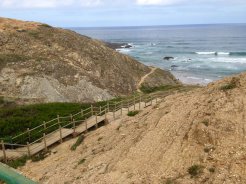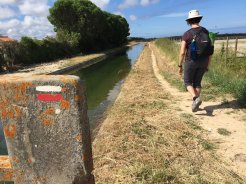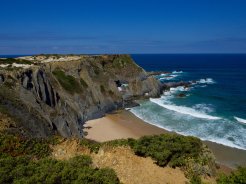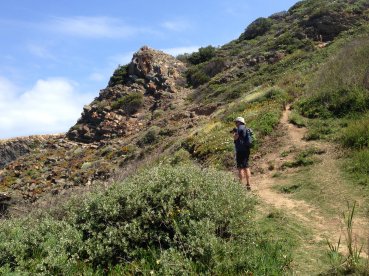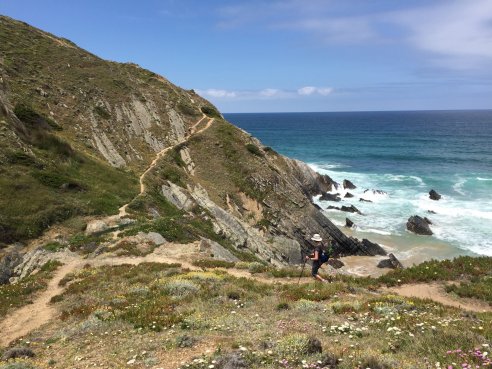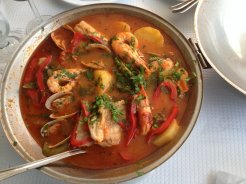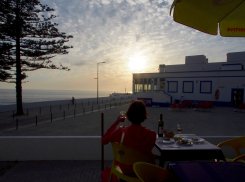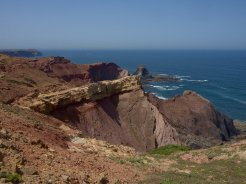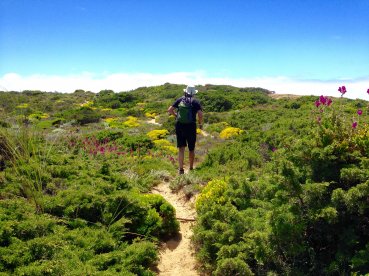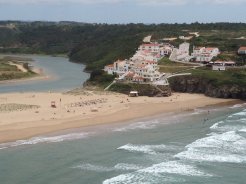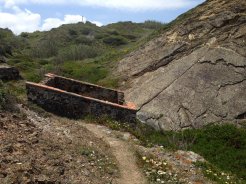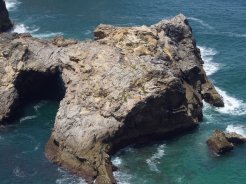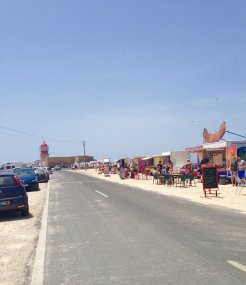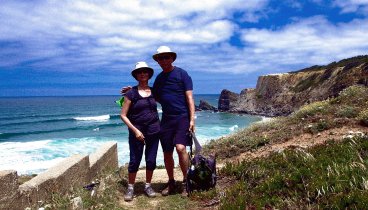Portugal Part One--Walking The Rota Vicentina
Portugal surprises us! We knew that this country is rich in history, known for its unique singing style of Fado and is celebrated for its wines and especially its Port. We read that Portugal, once one of the poorest nations in Western Europe, has experienced a significant increase in prosperity and has recently been named a "best value" travel destination, particularly if you are into golf!!
We are not into golf, of course, but had expected to view landscapes and have culture experiences much like those in Spain. We were so wrong! Everyday something surprises us, and this has allowed us to see that Portugal has a rich, unique culture and diverse landscapes quite different from its larger and more aggressive neighbour. There is so much more to this small peaceful country and we are so excited to explore it.
We have organized our visit to Portugal into four experiences: 1) walk while exploring the countryside; 2) recover on a warm sunny beach; 3) eat regional foods and drink the wine, and; 4) experience a bit of culture and history. For our first week we booked a self-guided 115 km walk of the Rota Vicentina along the southwest coast, organized by Ricardo from Vicentina Travel.
The Rota Vicentina is comprised of 400 kilometers of interconnected walking trails. There are two main "routes" to follow, the "Historical Way", which meanders inland through valleys and over ridges, and the "Fisherman's Way", which hugs the wild relatively uninhabited coastline. We decided to walk a combination of both "Ways" that includes the best of the coast and the more interesting towns and scenic valleys. We start at a town called Zambujeira and seven days later, averaging 20 kilometers a day, will end at the Cabo Sao Vincente, or Cape Vincent, the most westerly point of continental Europe.
After three buses and a train from Nerja, we arrive in Vila Nova de Milfontes on the south west coast. Ricardo from Vicentina Travel and his helper Phillip were waiting for us at the bus stop to drive us to our hotel in the next town. This transfer is not usually offered as most people organize a taxi themselves, but Ricardo immediately understood our dilemma that there were no viable transportation links to Zambujeira from where we were coming (we highly recommend this company for those who might be interested in following our footsteps).
When we were told that we would first stop by his "office" for our tour briefing, we had no idea that his office of the day was actually the restaurant/bar next door, that it overlooks a scenic river delta and expansive white sand beach, and that with the briefing we would enjoy our first glass of Portuguese vinho tinto.
What a vista! The landscape was surreal...and the fact that it was relatively undeveloped despite such "beach resort" potential was one of the biggest surprises about this country.
The next day we start our trek, putting one foot after another...
We walk from town to town in this self-guided tour following coloured markings on trees, poles and fences. We each carry a small backpack with a picnic lunch and lots of water while Ricardo organizes the transport of our luggage We do not meet many people on the trails. Ricardo told us that his self-guided tours had sold out for April and May and that most of the hikers were Canadian (a surprise!). We do meet Colleen, Canadian woman, at our second hotel, crossing paths with her on several occasions. Hiking on her own, she had made the error of booking with an Irish tour company (who apparently had never even hiked the trail) and was bemoaning the fact that she had little support and had become lost many times. Last time we saw her, she informed us that she was ending her walk even though she had a few more days to go, as the experience was not as she expected and she was suffering from toe issues. We feel extra grateful we are in good hands as we explore this fabulous country.
Each day begins with a good breakfast, mostly continental European-style. We will have scouted out the town the previous night to pick up picnic supplies, as there are few towns along the route for lunch. As we gather the needed picnic supplies, we find that almost all young people working in the stores and restaurants speak passable English. We are told that it is mandatory to learn English in school in Portugal. In one store I have a rather strange conversation with a man and I could tell he really wanted to practice his English language skills. He follows me around the store, explaining products that we pass. Before I know it he was explaining in broken English the misconceptions of Portguese history. Do we know it was not Christopher Columbus who was the hero of the times, but rather Vasco de Gama, the "bastard" son of the king (his mother apparently was Portuguese), who went east to establish a trading route to India? It is a name given little significance in our history books in North America. I nod in appreciation to the young man, but vow to refresh my knowledge of Portuguese history and the contributions of Vasco.
Each day ends with a celebratory beer at the first bar we see in our destination town. Never does beer taste so good than after seven hours on the trail! Portuguese beer is rather tasty (and this coming from a light beer drinker). In fact the food and drink of Portugal has been a real treat! Having tried to cook an "all Portuguese" meal prior to the trip, I had some assumptions about the cuisine. It seemed limited to fish, beans, potatoes and more fish and chicken with piri piri sauce. Was I wrong! Included with our tour package is a list of locally-owned restaurants in each town that we had overnight accommodation. All we try are of excellent quality and relatively inexpensive! One meal in particular far exceeds the rest -- a baked cod with an onion sauce, local sweet potatoes (a specialty of the region) and perfectly cooked vegetables--all for about $15. Len gets brave one night and has the local specialty of octopus stewed in beans. He raves about it for the rest of the night! And I vow that before I leave the country, I will eat a 'whole' fish as it is locally prepared...one that has head, tail, skin and bones still attached. (I just won't look at those dead beady eyeballs while digging in!).
We will not starve here. Or go thirsty! Wine has also been excellent. We really enjoy the vino verde (or green--meaning young--wine). It has a light effervescent flavour that is quite refreshing, and it doesn't hurt that it was also low in alcohol content! Noteworthy also is the robust Tempranillos, the Port wines and the Muscatels. Like Spain, it is more expensive to buy a bottle of water than a bottle of regional wine...this could prove problematic for two winos, with little will power to say no to a fabulous vintage.
Hiking the Fisherman's Trail is a combination of sheer terror, sheer joy and sheer torture! Most of the time the path leads us along the cliff edges, with sudden drop offs many many meters above the beach. It is a wild and spectacular landscape. My mantra is "Keep Your Eyes on the Path", and I unashamedly chant it out loud for the benefit of myself and Len. The fact that a national trail has no warnings, railings or land buffer along the edge creates sheer terror within me. We see many side trails veering off towards the cliff edges, making us wonder just how many people may have chanced fate to get a closer look at the ocean below. Not us!
However, one can not help but feel sheer joy when breathing the fresh salt-tinged air while surveying the overwhelming beauty of the landscape. Portugal's coast is not only rugged, and wild, but paradoxically appears to have been landscaped by professional horticulturalists. It is as if someone had spent time carefully choosing plants to coordinate colours and textures.
Yellow-leaf shrubs are evenly interspersed with pink, white and purple blooms, low spreading flowering bushes alternate with tall green grasses, and in between a unique ground cover of cactus creepers and mosses hide the sandy soil. The aroma is heavenly! Len remarked that it felt that we were walking in Portugal's "Buchart Gardens". Bravo, Mother Nature!
The only negative that we experience walking the cliff top trails is fact that it is sand on which we must walk for many kilometers. The cliffs are topped with rolling sand dunes, and while vegetation covers most of the surface, the trails are well-defined by the sand. The act of placing a foot into the soft deep sand, feeling it sink in, digging the toes in and straining the calf muscles to get traction in order to lift out the foot, then having to repeat with the other foot, for what seemed like an eternity...becomes " sheer torture" in the hot sun! There is much cause for celebration when a sandy trail ends and our feet feels the firmness of gravel, dirt or pavement again.
As we mindless place one foot in front of the other, there is much time for observation and reflection. Other than the conversations Len and I might engage in, it is virtually silent. Or is it? I muse on the definition of silence. I hear the bees and flies buzzing in the abundant flowers, the constant sound of waves crashing or wind passing through the trees. There are not many towns we pass through on route, so we hear little traffic and other man-made noises. It is peaceful as we walk and I start to compose a children's book in my head, one that, in our busy and noisy world filled with industry and technology, reminds us to find peace in sounds of nature.
Another thing that surprises us is how clean the landscape is. Unlike Spain, there is very little garbage on the streets and paths. Especially in the coastal towns, sand is swept regularly off public walkways. There are rarely overflowing garbage bins and dump sites. There are however, many abandoned buildings, old stone structures and crumbling foundations. We note many times that infrastructure for a whole subdivision have been been installed only never to be used. Some of the very small beach towns are virtual ghost towns for much of the year (inflating in population like Whistler on a seasonal basis). Construction of buildings of all sizes are started but are stopped for unknown reasons. And what may have been a historically significant church, fort or castle is often left to crumble into oblivion (or tagged with graffiti) on an accessible hillside or open field.
In fact, we are surprised at how few historical monuments there are to visit, at least in this southern coastal region of Portugal, compared to other places we've visited in Europe. And yet there is evidence that the people here do hold onto traditional ways. Men continue to balance precariously on high cliffs with their simple fishing rods dangling in the churning ocean below. Herders follow their cows around the pastures, swatting at the rebellious ones with a stick. Farmers fertilize their crops by hand as they walk through the freshly planted fields. And there are many squares and local bars where the old men of the town gather to commiserate and watch the world go by.
It seems obvious that this southern part of Portugal is slower to embrace the modern world than a lot of Europe. Farming and fishing dominate the lives of the people here, with tourism quickly gaining in importance. But the pace is slow, the people, while friendly when approached, go quietly about their daily business. Stores may not open on time, buses might not arrive, restaurants are closed for unknown reasons. There are no evening paseos, like the Spanish have, when the whole family dresses in their finest and strolls along the main streets or beach front promenades. I read with a chuckle that the difference between the Spanish and Portugueses is that the Spanish have a "get up and go" about them, but the Portuguese have a "got up and left" attitude.
This, of course, might not hold true after we visit the cities of Lisbon and Porto. We know that both cities have a vibrancy about them (in fact, we will be in Lisbon during the annual St. Anthony's Day, which celebrates the sardine in bizarre ways). But certainly here in the south, the attitude is laid-back and life is simple.
The Cabo Sao Vicente, our last destination, is historically significant. The Romans considered it a magical place where the sunset was much larger than anywhere else. They believed the sun sank hissing into the ocean, marking the end of the known world. It is the most westerly point on continental Europe--the last point of land that Portuguese sailors saw before heading into the unknown.
As we see the lighthouse on the cape get closer, we imagine ourselves standing alone in this revered place, celebrating our triumphant arrival and feeling of accomplishment. Not so...these historical and geographical factors have made this tiny peninsula very tourist-attractive... because when we finally walk the last 100 meters toward the lighthouse, it becomes clear that it draws many visitors, which in turn draws many vendors.
Tourist stands line the road, selling everything from fridge magnets, wool sweaters (it is a bit windy), beer and other drinks, and by far the most tacky item--the "Leizt Bratwurst vor Amerika"!! People were actually taking pictures of themselves standing below the vendor's sign and lining up for a bratwurst. We do our best to ignore the crowds, acknowledge the tiny lighthouse and head for the first stand for our usual celebratory beer.
We have been in Salema, on the south coast, for a few days now, recovering from our trekking experience. Both Len and I have blisters healing on our toes and I will lose four toenails. It is wonderful to be able to recuperate and relax in this tiny fishing and beach town. The weather has not been conducive to beach activities but it gives us the chance to reflect on our achievement of walking 115 kilometers on the Rota Vicentina. I am so proud that I was able to do this walk with few problems and with relative ease.
OK and now I WILL confess that I took a day off (only one), and travelled with the luggage to the next town, while Len completed the fourth segment of the walk on his own. I needed the time to rest my feet and gather my strength (and do laundry), and I am glad I took the time. Being with Len 24/7 is always wonderful, but I think having time apart is a healthy thing in a relationship and coming back together again is all the more special!
We are off to Lisbon tomorrow for a totally different experience...
Photos
- Many interesting sights along the way. -not sure what this is but it was penned up with ostriches and bison!
- Cliff walker
- Beginning the Rota Vicentina at Zambujeira
- Breath-taking view
- Selfie at another stunning location
- Check out the path ahead!
- Stunning hidden inaccessible beaches
- Our first sunset over the Altlantic iin Zambujeira Portugal
- Many towns had these old windmills-- this one is at Odeceixe near our hotel
- Many bridges cross the canal, which we followed for at least 20 kilometres!
- Beautiful wildflower along the irrigation canal
- image
- Cataplana--like a fish stew, and very yummy!
- image
- image
- image
- Can you see the fisherman on t he rock?
- Dramatic rock formations
- image
- One of the few beautiful beaches along the Rota Vicentina that has been developed
